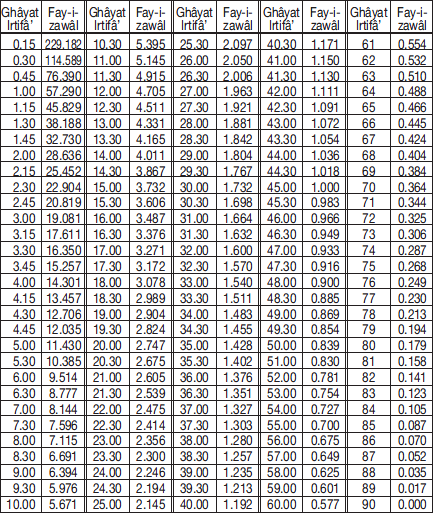Appendix VI
Sun’s Altitudes at Time of Late Afternoon Prayer
for Any Latitude

For instance, the Sun’s declination on
February 2 is -16.48o in Istanbul; hence, ghâyat irtifâ’
(point of solar culmination, the Sun’s maximum altitude) is
-16.48o +49o = 32.12o; fay-izawâl
(the shortest shadow) of a one-metre-long perpendicular rod is
1.58m.; and the length of its late-afternoon shadow is 2.58m.; and
the Sun’s late-afternoon altitude is 21.20o. The
fadli-dâir (temporal value of the arc of complement of the Sun’s
true altitude) is 2 hours and 41 minutes, which will be found by
using a calculator. Thereby the time of late afternoon will be
found to be 9.42 hours, adhânî, and 3.09 hours, in standard time,
since the equation of time is -13.39; (please see Appendix IV.) A
method to be used in the absence of the chart above is to get a
privileg calculator, touch the buttons for the computation:
90-32.12 --> o,,,= tan + 1 = arc tan MS 90-MR =
--> o,,, , and find the Sun’s altitude at the
time of ’asr-i awwal (the earlier time of late afternoon) to be
21.08o. There is yet another method: The Rub-i-dâira
(quadrant). Its khayt, (thread that represents the daily rotation,)
is brought over the number representing theghâyat irtifâ’; the
number on the arc of zill-i-mebsût and crossed by the khayt shows
the length of the shortest shadow termed fay-i-zawâl.




